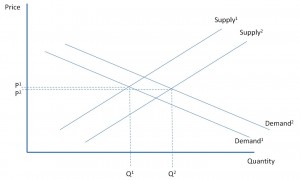The demand for “metrics” is increasing. At the same time, data availability is accelerating. More, the availability of survey software like SurveyMonkey has driven down both the cost and accessibility to survey tools. In economic parlance, we’ve seen both supply and demand shift out. As the chart shows, the end result is a lower price and a much higher quantity.
This is in everywhere evident. Political and social issue polling has increased with a 24 hour news cycle, cable news channels, more independent research institutions, and think tanks. Surveys have become commonplace. I receive a survey invite each time I stay in a hotel, attend an event, close an account or any number of a host of activities. These invites enter my inbox with subject lines like “your opinion counts,” “please share your feedback with us,” “your recent stay at Renaissance,” or “would you recommend Hertz?”
A deluge of surveys (and information overrun generally) is lowering response rates. Surveys fielded via telephony must be heavily weighted after the fact to offset skewed response rates of older individuals (because younger individuals are increasingly foregoing landlines and because older consumers are more inclined to take the time to respond to phone inquiries from strangers). A drive to survey ever specific segments of the population is stretching what is possible. These are only a sampling of issues blitzing survey research and I don’t see these issues abating anytime soon.
While economists generally consider survey data qualitative research, primary research (ie survey) professionals consider it quantitative research. Beyond declines in cost and accessibility, demand has increased because topline results can easily be interrupted and are being used for things like benchmarking. Many consider themselves adept at writing quick surveys and for tracking surveys like the hotel surveys listed above, the survey mechanism scales extremely well because the same survey is delivered to everyone who stays the night. An increasing number of firms are using survey topline results in goal accomplishment measurement – which only exacerbates the demand.
I do think well executed surveys can provide tremendous value – especially when results are used in conjunction with other metrics and herein lies any future for survey research. Metrics on almost everything are becoming increasingly available in real-time. In many instances metrics that weren’t historically being captured are now being recorded. This was a trend I discussed at length before and after the 2011 CES. Examples abound – like the Withings WiFi body scale which records weight, BMI, percent muscle and percent fat. This information can be accessed across a variety of device/OS configurations and is recorded overtime, creating a sequence of data points or time series.
I’ve written about how information will increasingly be overlaid to reveal in a mosaic fashion insights that can’t be gleaned by looking at these streams of information by themselves. Imagine for example tying data from the Withings body scale with your credit card information and your calendar. You could see if there are certain restaurants or other events that impact your goal objectives.
Today, where this information does exist it isn’t readily shared, but in the realm of survey research, researchers frequently provide incentives to encourage survey response. A similar approach will likely emerge with these “hard” metrics. In many instances, these metrics will completely replace survey research. Why ask someone what TV shows they watched for example when, everything being displayed on their screens is already being measured. Deb Roy’s experiment shows what is entirely possible. In some cases, having these metrics should actually make survey research more robust and meaningful – not what TV program you watched, but why you watch (or didn’t watch) a given program. Though here again, much of this analysis will be driven by overlaying multiple levels of data. The dilemma for research moving forward is to find relevancy for survey research and the capabilities to digest the troves of data that will exist because of sensor-enabled technologies.



